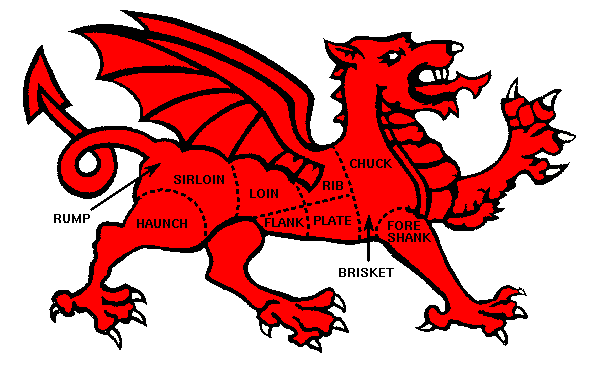

5 lb leg of lamb
5 oz chopped onions
5 oz chopped carrots
5 oz chopped celery
3 cloves garlic, chopped
2 Tablespoons oil
1 bay leaf
1 teaspoon dried thyme
4 sprigs parsley
1 teaspoon dried rosemary
½ teaspoon coriander
1 teaspoon black pepper
3 teaspoons salt
2½ cups dry red wine
2/3 cup red wine vinegar
for the roasting
2 slices unsmoked bacon, optional
2 leeks, sliced
2 stalks celery
2 medium onions, halved
as many potatoes as you can fit (about 3 lbs)
2 carrots
Preheat oven to 325°. Lightly brown the bacon. Place the bacon, lamb and strained marinade in a deep roasting pan and surround with the leeks and celery. Bake 30 minutes per pound. An hour or so before the meat is to come out of the oven, surround it with the onions, potatoes, and carrots. Let the roast rest at least 30 minutes before carving.

It's been virtually impossible to determine the origin of this recipe. It appears that the British usually cook their lamb in red wine or cider (and even with a jigger or two of gin), but no other cook (bar Michael Hjort, chef-owner of Melton's in York, but his recipe is so similar to Grigson's that hers no doubt inspired his) thinks the marinade is used to make the lamb taste like game. Historically the process would be just the reverse: vension marinated to taste like lamb, say, so that no-one would know that the source of the evening's meal had been poached from His Majesty's forest.
There is a very similar Greek dish, called Kapama, in which lamb shanks are braised for hours in a spicy, winey tomato sauce, but it tested poorly.
Grigson suggests you marinate pork the same way to taste like wild boar. So... using 3½ lb center cut pork loin roasts, substitute dry cider for the red wine and cider vinegar for the wine vinegar in the marinade, and roast them with potatoes, onions, and perhaps sauerkraut, in a 325° oven for 40 to 45 minutes per pound. In our tests, the temperature of the centers averaged around 153° when we removed them from the oven and peaked at 162° during the half hour rest, well past the safety minimum of 140°. A 3½ - 4 lb roast would serve four as the sole meat course. Yup, a rib apiece. Or, if serving other meat courses, you can stretch a four pound roast to feed eight. *sigh* Feeding an army... You will need to adjust the time and temperature depending on the size and cut of your meat.
By all means serve with a crisp green salad, say Salad Pen y Bont
First served: Beltane 1994 |
 |
Last modified: © October 1995 |